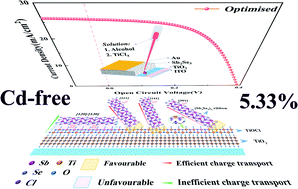Remarkable Cd-free Sb2Se3 solar cell yield achieved by interface band-alignment and growth orientation screening†
Abstract
Sb2Se3 has attracted a lot of attention in recent years owing to its excellent photoelectrical properties. Eco-friendly TiO2, with its wide band gap, is a promising candidate for the electron transporting layer (ETL) of Cd-free Sb2Se3 solar cells. However, the undesirable band alignment of the TiO2/Sb2Se3 interface hinders its wide application. Herein, a TiCl4-passivated TiO2 ETL was introduced to solve this problem. The incorporation of Cl atoms leads to the enhanced (101) orientation of anatase TiO2, by which the growth orientation of the Sb2Se3 film could be effectively tailored. The performance of the Sb2Se3 device with TiCl4 treatment was dramatically enhanced by the improved band alignment at the TiO2/Sb2Se3 interface, decreased interface defects, a pinhole-free ETL and enhanced crystal orientation. Finally, the synergetic improvement of the device parameters yielded a best device efficiency of 5.33% for a configuration of ITO/TiO2/Sb2Se3/Au. In this configuration, the preferred band offset renders the highest open circuit voltage (Voc) value (394 mV) in a Cd-free Sb2Se3 solar cell processed using vapor transport deposition (VTD). This work is expected to provide helpful guidance for future experimental efforts to improve Cd-free device performance and interface quality.



 Please wait while we load your content...
Please wait while we load your content...